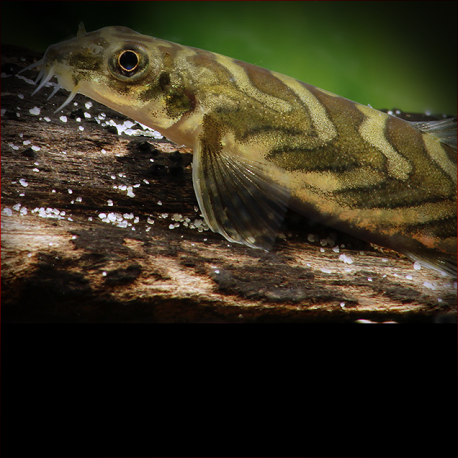More info
Datasheet
| Minimum Tank Size | 90 litres / 23.78 US gallons |
| Maximum Size | 6.0cm / 2.36inches |
| Temperature | 18°C / 64.40°F - 25.5°C / 77.90°F |
| Hardness | 2.02dgH / 36ppm - 12.05dgH / 215ppm |
| pH | 6.0-7.5 |
General Description
The Mesonoemacheilus Triangularis, commonly known as Zodiac Loach or Batik loach, is characterized by its unique body patterning with pale, oblique saddle-like markings edged in black running along the dorsal surface. The species displays variable patterning, with older individuals having more diverse markings compared to younger fish that exhibit conjoined markings forming band-like patterns. It is easily distinguished from other Mesonoemacheilus species by its distinct coloration.
Aquarium Setup
Setting up an aquarium for the Zodiac Loach involves replicating its natural habitat of clear, well-oxygenated, headwater streams. Tank requirements include a substrate of rocks, sand, gravel, and water-worn boulders, with driftwood branches for shelter. Hardy aquatic plants like Microsorum, Bolbitis, or Anubias can be added. Maintaining high dissolved oxygen levels and water movement is crucial, necessitating power filters, powerheads, or airstones. Regular water changes of 30-50% tank volume are essential to ensure pristine water quality.
Behaviour
In captivity, the behaviour of M. triangularis can vary significantly among individuals, with some reported to be peaceful while others display territorial and sometimes aggressive tendencies. It is advisable to exercise caution when introducing this species to a community tank, as they may exhibit extreme territorial behavior. Maintaining them in groups can be beneficial, and while they are generally tolerant of conspecifics, territorial aggression may arise in certain situations.
Feeding and Diet
Zodiac Loaches are omnivorous, with a diet consisting mainly of small insects, worms, crustaceans, and zooplankton. In captivity, they accept dried foods but should be supplemented with small live and frozen fare such as Daphnia, Artemia, and bloodworms for optimal health and coloration. Feeding a varied diet is essential to meet their nutritional requirements and support overall well-being.
Reproduction & Dimorphism
Successful breeding of M. triangularis in captivity has been reported, with adult pairs spawning in a separate tank containing spawning mops and gravel. Female loaches are likely to grow slightly larger and develop a rounder belly when gravid, while males may exhibit thickened pectoral-fin rays with tubercules. Careful observation and appropriate conditions are necessary for the successful breeding of this species.
Habitat and Distribution
Native to rivers draining the Western Ghats mountain range in India, the Zodiac Loach inhabits headwater streams with clear, fast-flowing water. These streams are typically shaded by forest cover, with a substrate of sand, gravel, rocks, and boulders covered in algae and detritus. Although aquatic plants are usually absent, certain species have been observed in lower-gradient habitats. This species is locally abundant in river systems in Kerala and Tamil Nadu, where it is known to occur in large aggregations.
Ensure water conditions in the aquarium are maintained within a temperature range of 18-25.5°C, pH of 6.0-7.5, and hardness of 36-215 ppm to mimic their natural habitat and support their well-being.

